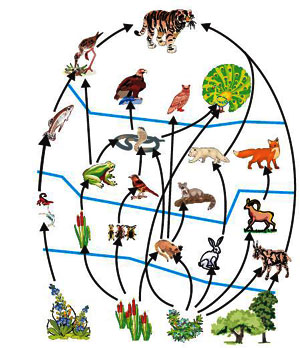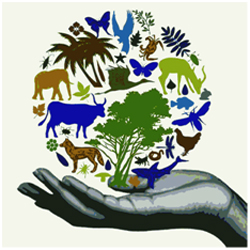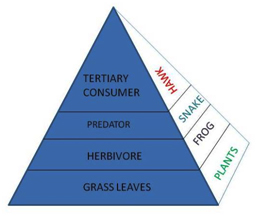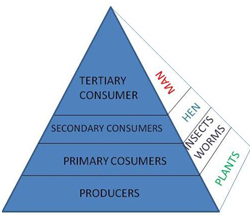9.Our Environment – Our Concern
9. Our Environment – Our concern

Synopsis :
- The world of living things is termed as “Biosphere”.
- Within the biosphere, there are a number of major ecosystems.
- The terrestrial ecosystems are being determined largely by the variations in climatic conditions between the Poles and Equator.
- The main climatic influences which determine these ecosystems are rainfall, temperature and the availability of light from the sun.
- Food chain shows - how energy passed from one organism to another.
- The arrows between each item in the food chain always point from the food to feeder.
- Pyramid of the numbers, pyramid of biomass and pyramid of energy are other ways to show food relationship and flow of energy among other living things.
- A pyramid is a structure whose shape is roughly that of a pyramid in a geometric sense.
- The concept of ecological pyramid was first introduced by a British Ecologist Charles Elton in 1927.
- Pyramid of number shows the population of organisms at each tropic level in a food chain.
- Biomass is organic material of biological origin.
- Pyramid of biomass represents the available food as a source of energy at each tropic level in the food chain.
- It is found that 10-20% of the biomass is transferred from one tropic level to the next in a food chain.
- Biomass can also be used as a fuel.
- Pyramid of energy represents the available energy at each tropic level in the food chain.
- The ratio between energy flows at different tropic levels along the food chain expressed as percentage is called “Ecological Efficiency”
- Slobodkin (1959) suggested that transfer of energy from one tropic level to the next is of the order of 10% and this is called “Gross Ecological Efficiency”.
- Ten percent law was initially observed by Lindeman (1942).
- Steele proved that the gross ecological efficiency is about 20% to 30% in 1974.
- Toxic material used to prevent the pest, fungus and other disease away from the food crop and grains do harm the ecosystem in many ways.
- Bioaccumulation is the entering of the pollutants in the food chain.
- The tendency of pollutants to concentrate as they move from one tropic level to the next is known as “Biomagnification”.
- There are several alternatives of pesticides through which we can get more crops with less harm like rotation of crops, biological control, development of genetic resistant strains, etc.

Four Marks Questions
- Write a short note on pyramid of number for any food chain. What can we conclude from this pyramid of numbers?
i) Tree ii) Insect iii) Woodpecker
Ans: a)- the number of organisms in a food chain can be represented graphically in a pyramid is called pyramid of numbers.
- Each bar represents the number of individuals at each tropic level in the food chain.
- At each link in a food chain, from the first order consumers to large carnivores, there is normally an increase in size but decrease in number.
- For example in a forest, the aphids are very small in size and occur in astronomical numbers, the lady birds which feed on them are distinctly larger and not so are numerous.
- The insectivorous birds like hawks which feed on the lady birds and are only presents in small numbers.
- Sometimes, the pyramid of numbers does not look like a pyramid at all just like pyramid asked in the question.
- This could happen if the producer is a large plant such as tree (or) if one of the organisms at any trophic level is very small.
-
Whatever may be the case, the producers still goes at the bottom of the pyramid.
- What is biomass? Draw a pyramid of biomass for the given food chain.
i) Grass leaves ii) Herbivores iii) Predators iv) Hawk
 PYRAMID OF BIOMASS
PYRAMID OF BIOMASS
Ans:- Any type of plant or animal material that can be converted into energy is called biomass.
- The pyramid of biomass represents the relationships that exist between the quantities of living matter at different trophic levels.
- In terrestrial ecosystems, the biomass progressively decreases from producers to top carnivores.
- How is using toxic material affecting the ecosystem? Write a short note on bioaccumulation and biomagnifications.
Ans:- Indiscriminate use of pesticides lead to the destruction of many other species along with pets in the ecosystem.
- Some of these may be predators which naturally feed on these pests, some other may be the food of other animals.
- These may lead to unpredictable changes in food chains and upsetting the balance within the ecosystem.
- Some of the pesticides which contain mercury, arsenic or lead are non-biodegradable. These are potentially dangerous as they accumulate in the bodies of animals and pass right through the food web.
-
Being further concentrated at each step until animals at top of pyramid may receive enough to do considerable harm.
Bio-accumulation: The process of entering of pollutants in a food chain is called ‘bio-accumulation’.
-
When pesticides are sprayed, they mix up with soil and water. These are absorbed by the plants along with water and minerals.
- When herbivores consume this plant food, then these pests go into their bodies through the food chain.
- When the carnivores consume these herbivores, then the pesticides get transferred to their bodies.
- Pesticides enter the food chain at the producer level.
Bio-magnification: “The tendency of pollutants to concentrate as they move from one tropic level to the next is known as bio-magnification”.- Pesticides get accumulated at each tropic level, as they are non-biodegradable substances.
- Since human beings occupy the top level in any food chain, so the maximum amount of toxic pesticides get accumulated into the bodies.
- Medical tests have proved that the most commonly used pesticides like. D.D.T is accumulating in our bodies through food chains leading to health hazards.
- Observe a plant in your kitchen garden, and write a note on producer consumer relationship.
Ans:- 1. In our garden, I selected lxora plant to study the producer-consumer relationship.
- The plant synthesizes its own food through photosynthesis
- Small aphids, ants and other orthropods which dwell on this plant get shelter and food from this.
- If also observed some earthworms making burrows at its base making aeration of the soil. The excreta of earthworms enrich the soil with organic matter. In return, these get their food from fallen leaves of the plant.
- Birds like sparrows and lady bird feed on these aphids and earthworms at secondary consumer level.
- Crows and Hawks often trouble these carnivorous birds. These may be considered as tertiary consumers.
- All these are maintaining their lives in a stable ecosystem.
- What type of information do you require to explain pyramid of biomass?
 PYRAMID OF BIOMASS
PYRAMID OF BIOMASS
Ans:- A more accurate idea of food relationship must be necessary to explain the pyramid of biomass.
- The mass of plant matter which is consumed by the herbivores is also necessary.
- In the similar way, the mass that is produced by the primary consumes by consuming plant matter, the total mass of the secondary consumes that could be supported by the primary consumers and so on through the chain. This information is also necessary to explain pyramid of biomass.
TWO MARKS QUESTIONS:
- What happens to the amount of energy transferred from one step to the next in a food chain?
Ans:- There is a continuous transfer of energy from one tropic level to next trophic level in an ecosystem.
- There is loss of energy at each energy transfer in various tropic levels of organisms, which goes into the environment and remains unutilized.
- As we move from first tropic level of producers to second trophic level of primary consumers and third level of carnivores, the amount of energy available gradually decreases.
- What do pyramids and food chain indicate in an ecosystem?
Ans:- Food chains in an ecosystem indicate food relationships among living organisms.
- The arrows between each item in the chain always point from the food to the feeder.
- Food chain indicates the flow of energy from one organism to another.
- Pyramids are another type of graphical representations which show flow of energy from one organism to another.
- In the ecological pyramid, the producers are represented at the base (I tropic level) and the other successive tropic levels (primary, secondary and top consumers) are represented one above the other with top carnivores at the tip.
- Should we use pesticides as they prevent our crop and food from pests or should we think alternatives? Write your view about this issue and give sound reason for your answer.
Ans.- The time has come to think about the ways through which we can prevent ourselves and other living from the harmful effects of the use of toxic pesticides.
- The answer to this problem is to find other effective methods of controlling pets which have less harmful effects and are based on the sound biological principles.
- The alternatives of pesticides through which we can get more crops with less harm like rotation of crops, biological control of pets, vermicompost, using bio-fertilizers and development of genetic resistant strains.
- What is a tropic level? What does it represent in an ecological Pyramid?
Ans.- In a food chain, at which the transfer of food (or) energy takes place is called a tropic level.
- The green plants are producers and constitute the first tropic level in the ecological pyramid.
- Primary consumers (or) Herbivores which feed upon plants constitute the second tropic level.
- Carnivores which feed upon carnivores constitute the third tropic level
-
Top carnivores (or) Tertiary consumers which feed upon small carnivores constitute the fourth tropic level.
- If you want to know more about flow of energy in an ecosystem, what questions do you ask?
Ans:- What is ecological efficiency?
- What is the difference between Gross ecological efficiency and Net ecological efficiency?
- Why the flow of energy in a food chain happens is unidirectional?
- What is the significance of 10% Law?
- How does a food chain represent the flow of energy?
- What will happen if we remove predators from food web?
Ans:- If we remove predators from a food web, then there will be no predator control over the population of herbivores.
- Due to this, the population of the herbivores will increase dramatically.
- Increase in herbivores population lead to excessive grazing of grass. The density of producers will be very much reduced.
- Over grazing may even eliminate the grass and other plants and the grassland is turned into desert.
-
Draw a pyramid of numbers; consider yourself as top level consumer.

- Prepare slogans to promote awareness in your classmates about eco-friendly activities.
- Save energy- Save Lives
- ‘No’ to bikes and cars – ‘Yes’ to Bicycle
- Encourage Friendly Insects – Discourage Toxic Pesticides
- Bio-remediation – Saves our Future Generations.
- Suggest any three programmes for prevention of soil population in view of avoiding pesticides.
Ans.- We should encourage crop rotation in agricultural fields.
- ’Mixed Crops’ and ‘aakarshaka patralu’ are very useful in preventing pests in a natural way.
- Bacillus Turingenesis, Trichoderma Bacterium can prevent the attack of pests to crops very effectively in a natural way.
- Development of genetically resistant strains which do not need chemical pesticides.
- Usage of bio fertilizers and vermicompost should be encouraged.
One Mark Questions
-
What is Biosphere?
Ans. The world of living beings is called ‘biosphere’. [Or]
The life supporting zone on the earth is termed as ‘biosphere’.
-
What does as food chain show?
Ans. A food chain shows who eats what in a particular habitat.
-
What is food web?
Ans. Food web is the elaborate interconnected feeding relationships in an ecosystem. Many of the food chains in an ecosystem are cross linked to form of web.
-
What is an ecological pyramid?
Ans. A graphical representation of the feeding level structure of an ecosystem by taking shape of a pyramid is called ‘Ecological Pyramid’.
-
What is pyramid of numbers?
Ans. A graphic representation designed to show the number of organisms at each tropic level in a given ecosystem is called ‘pyramid of numbers’.
-
What is biomass?
Ans. Biomass is organic material of biological origin that has ultimately derived from the fixation carbon dioxide and the trapping of solar energy during photosynthesis.
-
What is bio-fuel?
Ans. Biomass used for energy production is called ‘bio-fuel’.
-
What is pyramid of biomass?
Ans. A graphic representation designed to show the quantity of living matter at each tropic level in a given ecosystem is called “pyramid of Biomass”.
-
What is ten percent law?
Ans. During the transfer of energy from one tropic level to the next only about 10% of energy from organic matter is stored as flesh. This is called ‘ten percent law’.
-
What is Bioaccumulation?
Ans. The process of entering of pollutants in a food chain is known as ‘Bioaccumulation’.
- What is biomagnifications?
Ans. The tendency of pollutants to concentrate as they move from one tropic level to the next is known as “biomagnifications”.










